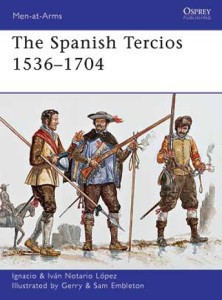Ignacio and Ivan Lopez
The Spanish Tercios 1536-1704
(Osprey, 2012) 48pp. $13.95
In this 481st offering of the Osprey Men at Arms series, Ignacio and Ivan Lopez, and their illustrators, Gerry and Sam Embleton, have written a useful volume on the history of the Spanish tactical unit, the tercio, from its inception in the mid-16th century to the turn of the 18th century, the period the zenith of the power and prestige of the Spanish army. It includes the usual detailed color plates, pictures, and diagrams found in the entire Osprey series.
The authors begin with a good, but brief, overview of the political and military situation in both late fifteenth early sixteenth century Italy and Spain. They touch on the end of the Reconquista and the entirety of the Italian Wars, describing them as the “cockpit of Franco-Spanish rivalry” at the beginning of the sixteenth century. The authors also describe the influence of a group of Swiss mercenaries in the kingdom of Castile at the end of the fifteenth century. This contingent was hired to not only teach the Swiss-style of infantry combat, but also serve as an example of the efficacy of discipline and training for the newly united Spanish monarchy’s professional army. The tercio was born from this initial contact.
This section also highlights the early influences of Gonzalo Fernando de Cordoba, el Gran Capitan, appointed by Ferdinand to oppose the French invasion of Charles VIII in 1494. The Lopez depict Cordoba’s reorganization of the Italian army of Spain along classical Roman lines, with 12 capitania of 500 infantry each making up a 6000 man coronelia. Each capitania consisted of 200 pike, 200 sword and buckler, 100 arquibusiers, with 2 made up of solely pike. Witness Machiavelli’s similar Florentine militia organization two decades later. This section goes on to give the recipe of Cordoba’s success in Italy, namely tactical battlefield fortifications combined with the early embracing of effective gunpowder weapons. Also contained in this section is a very useful chronology highlighting the ebb and flow of continental wars in the sixteenth and seventeenth centuries where the tercios were employed.
The next sections highlight the history and unit organization of during the two centuries of the tercio’s existence. By the middle of the sixteenth century the tercio, while ostensibly a fraction of the total Spanish force, could be seen as the first (non-elite) national, professional organization in modern military history. Interestingly enough, the designation of “tercio” is still used by the modern Spanish army making them the longest continuously existing military unit in the world. The authors point out that not only were Spaniards recruited for the tercios, but eventually national troops from throughout the Hapsburg empire made up a large majority of the total Spanish force throughout seventeenth century European conflicts.
The section on Rank and duties cover both the officer corps and rank and file soldiers and provides an interesting etymology for the most commonly used terms for modern rank distinctions (capitan, Sergento, etc.). Also covered are recruitment, training, and morale of the tercios. This section contains an ironic section extolling the discipline and command control of Tercios, which were responsible for some of the most gruesome civilian atrocities in the history of early modern warfare.
Well researched discussions of equipment, tactics, and uniforms round-out the book. The Lopez engage in a short discussion of the changing role of the sword in the Spanish army, which The use of “sword and buckler men” in the early history of the Italian Wars would benefit from further examination. The changing nature of the tactics of the Tercio is well explained with the aid of illustrative diagrams. The authors assert in this section that the arquibusier of the Tercio used an early form of rolling volley fire years prior to the invention of the tactic usually attributed to Maurice of Nassau. Again this question is worthy of further study.
While this book is very workman-like and useful study for student of the early modern warfare, it has certain limitations inherent in much of the Osprey series, namely a lack of foot or end notes, a limited bibliography which would be improved with the inclusion at least a few sources in English, and a more fully developed section on the use of the tercio in the later Italian wars. That being said, The Tercios 1536-1704 is an admirable addition to the rather meager shelf of works dedicated to warfare in the early modern period.
Jay Roberts
[email protected]

